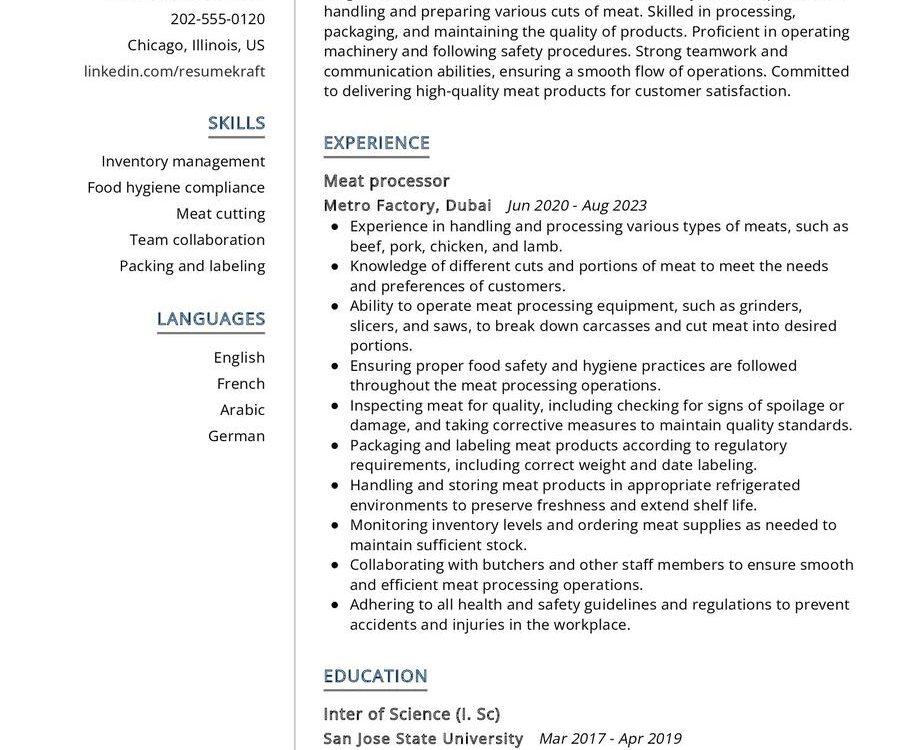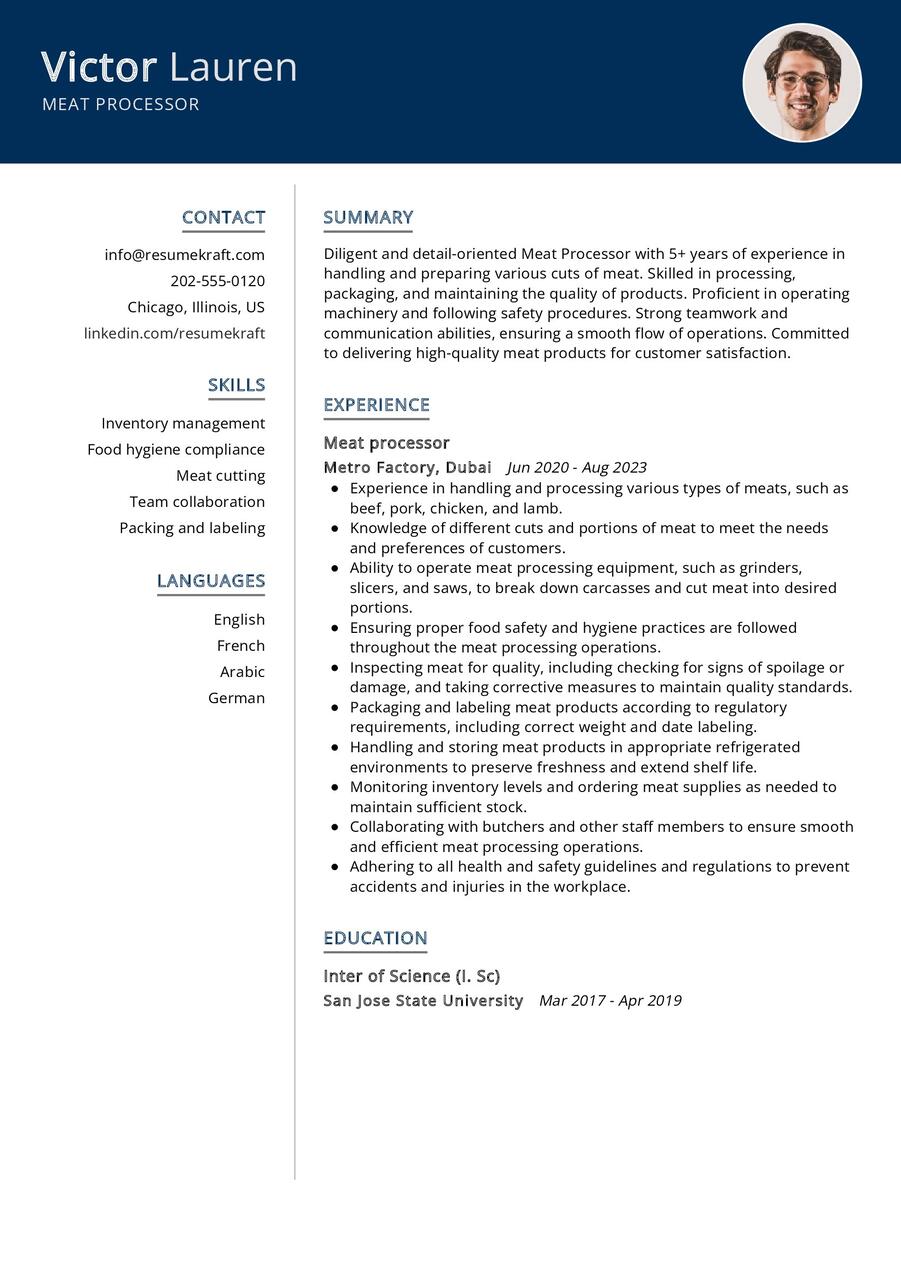Exploring the Role of a Meat Processor
As the demand for high-quality meat products continues to rise, the role of a Meat Processor has become increasingly crucial in the food industry. This position involves a unique blend of technical skills, attention to detail, and a commitment to ensuring the production of safe and delicious meat products. In this comprehensive guide, we will delve into the multifaceted role of a Meat Processor, the necessary job requirements, and tips on crafting an impressive CV for this specialized profession.
What are the Meat Processor Job Requirements?
Embarking on a career as a Meat Processor requires meeting specific requirements to excel in this dynamic field. Let’s explore the prerequisites one needs to fulfill to embrace the role of a Meat Processor:
- A high school diploma or equivalent, providing a foundational understanding of basic educational concepts.
- Demonstrated knowledge of meat processing techniques and equipment, showcasing expertise in the field.
- Experience in meat cutting and butchery, illustrating a hands-on approach to the profession.
- Understanding of safety regulations and hygiene standards in meat processing, ensuring compliance with industry guidelines.
- Physical stamina and dexterity, essential for the manual aspects of the job.
- Basic mathematical skills for accurate measurement and portioning of meat products.
- Effective communication skills to collaborate with team members and supervisors.
Securing additional certifications in food safety and handling can further enhance your profile in the competitive job market.
Responsibilities of a Meat Processor
The role of a Meat Processor is diverse, encompassing a range of responsibilities that contribute to the production of high-quality meat products. Let’s unravel the core responsibilities that define this role:
- Performing meat cutting, trimming, and portioning according to specified requirements, ensuring product consistency.
- Operating and maintaining meat processing machinery, adhering to safety protocols and minimizing downtime.
- Inspecting meat products for quality, identifying and removing any defects or impurities.
- Collaborating with team members to meet production targets and deadlines.
- Adhering to sanitation and hygiene standards to guarantee the safety of meat products.
- Assisting in inventory management and stock rotation to minimize waste and ensure freshness.
- Continuously updating knowledge of meat processing techniques and equipment.
Each responsibility plays a crucial role in delivering top-notch meat products to consumers.
Meat Processor CV Writing Tips
Crafting a compelling CV is essential for standing out in the competitive job market. Here are some tips to help you create a Meat Processor CV that showcases your skills and experiences effectively:
- Highlight your hands-on experience in meat cutting and butchery, emphasizing your proficiency in meat processing techniques.
- Detail any certifications related to food safety and handling, demonstrating your commitment to industry standards.
- Include specific examples of how you contributed to the efficiency and quality of meat production in your previous roles.
- Showcase your ability to work collaboratively in a team, as effective communication is crucial in meat processing environments.
- Quantify your achievements where possible, such as meeting production targets or reducing waste.
Each tip is a step toward creating a CV that resonates with potential employers in the meat processing industry.
Meat Processor CV Summary Examples
Your CV summary serves as an introduction to your professional journey. Craft a powerful snapshot with examples like:
- “Experienced Meat Processor with a proven track record in precision cutting and quality control, ensuring the production of top-grade meat products.”
- “Detail-oriented Meat Processor adept at operating and maintaining processing machinery, contributing to a streamlined and efficient production process.”
- “Team-oriented Meat Processor with a focus on collaboration and adherence to safety standards, ensuring the delivery of safe and high-quality meat products.”
Your CV summary sets the stage for your expertise and achievements in the meat processing field.
Create a Strong Experience Section for Your Meat Processor CV
Your experience section is the heart of your CV, narrating your journey in the meat processing industry. Here are examples to guide you:
- “Led meat cutting and portioning team, achieving a 15% improvement in production efficiency through strategic process optimizations.”
- “Implemented a rigorous quality control system, resulting in a 20% reduction in defective meat products and improved customer satisfaction.”
- “Collaborated with cross-functional teams to introduce new meat processing techniques, contributing to the overall innovation and efficiency of the production line.”
Each experience is a chapter in your career book, showcasing your impact and contributions to the meat processing industry.
Sample Education Section for Your Meat Processor CV
Your educational background forms the foundation of your career. List your educational milestones like:
- High School Diploma, XYZ High School, a foundation in basic education, 2014.
- Certification in Food Safety and Handling, ABC Institute, ensuring adherence to industry standards, 2016.
Each educational qualification is a testament to your commitment to learning and excellence in the meat processing field.
Meat Processor Skills for Your CV
Your skill set is your toolkit, showcasing your abilities in the meat processing domain. List essential skills, both soft and hard, for a Meat Processor CV:
Soft Skills:
- Hands-on experience in meat cutting and butchery, showcasing technical proficiency.
- Effective communication and collaboration in a team-oriented environment.
- Attention to detail, ensuring the quality and consistency of meat products.
- Adherence to safety and hygiene standards in meat processing.
- Physical stamina and dexterity for manual aspects of the job.
Hard Skills:
- Operation and maintenance of meat processing machinery.
- Quality control in meat processing, identifying and addressing defects.
- Inventory management and stock rotation to minimize waste.
- Continuous learning about new meat processing techniques and equipment.
Each skill is a tool, contributing to your success as a Meat Processor.
Common Mistakes to Avoid When Writing a Meat Processor CV
Steer clear of common pitfalls when crafting your CV to ensure it stands out positively. Avoid these mistakes:
- Avoid generic CVs; tailor your CV to the specific requirements of the meat processing industry.
- Highlight achievements, not just job duties, to provide depth to your professional narrative.
- Include a cover letter to complement your CV, providing additional insights into your passion and suitability for the role.
- Use industry terminology judiciously; too much technical jargon can obscure your true value.
- Proofread your CV meticulously to maintain a professional image.
Avoiding these mistakes ensures your Meat Processor CV is authentic and compelling, increasing your chances of landing your desired role.
Key Takeaways for Your Meat Processor CV
As we conclude this comprehensive guide, remember these key points while crafting your Meat Processor CV:
- Emphasize your hands-on experience and technical proficiency in meat cutting and processing.
- Showcase your commitment to safety standards and continuous learning in the meat processing industry.
- Quantify achievements and contributions to highlight your impact in previous roles.
- Craft a CV tailored to the specific requirements of the meat processing industry.
Finally, feel free to utilize resources like AI CV Builder, CV Design, CV Samples, CV Examples, CV Skills, CV Help, CV Synonyms, and Job Responsibilities to create a standout application and prepare for the Meat Processor job interview.
Armed with these insights and tips, you are now ready to craft a CV that is a true reflection of your journey, your skills, and your aspirations in the meat processing industry. Best of luck!


